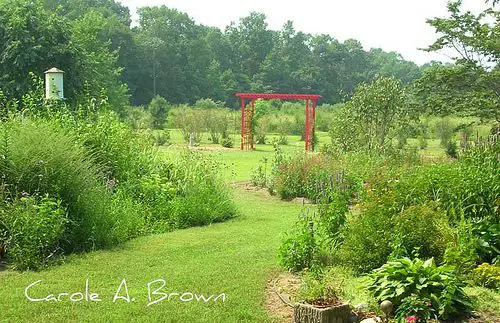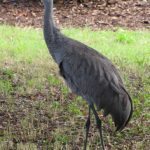The American Lawn is the Best Illustration of Unsustainable Practice
In order to fully understand sustainability in ecosystem gardening, it is quite illuminating to look at examples of unsustainable practice. There is no better illustration of this than the American lawn. We have idealized this concept so much that it has become the norm no matter where in the country you live.
Suburban developments have regulations specifying lawn height, and I know many people who have discovered the hard way just what breaking those rules means: nasty looks from neighbors, fines from the Owner’s Association, and social ostracization. For a country who prides itself on individuality, it makes no sense that we expect every yard to look exactly the same.
Lawns are Monocultures: a Biological Desert
Simple ecosystems, like monoculture lawns, support very few other species. In fact, lawns have been called biological deserts because of the paucity of other species they support. They are prone to disease, insect outbreaks, and invasive species. Nutrients are lost when clippings are removed, requiring large amounts of chemical inputs to sustain them. This type of system cannot sustain itself, but requires constant attention.
Lawns are the Largest Irrigated Crop in the United States
Recent satellite photographs have shown that lawns (residential and commercial sites, golf courses, etc.) now occupy 45.6 million acres, or 23% of urbanized land, which is 3 times the size of New Jersey.
Trends in development from urban to suburban to exurban areas mean that this percentage will only grow larger. This makes the American lawn the largest irrigated crop in the United States in terms of surface area, taking up more space than even corn, and the largest irrigated crop grown in the country.
Maintaining the lawns in this country requires vast amounts of water. Conventional construction practices in this country supply homes solely with potable drinking water, which in many areas of this country is in very short supply.
Lawn irrigation on the east coast of the United States accounts for 30% of water use; on the west coast water used for irrigation is 60% of available water. Having spent a lot of time in Arizona over the past several years, where there is enormous contention between communities over water availability, I have discovered that the ideal of the American lawn in this area of the country is sheer folly.
Lawns Contribute to Stormwater Runoff
During the course of construction lawn areas become extremely compacted, preventing infiltration by rainwater. This compaction continues after construction as lawns are continually mowed, played on, and walked on.
This makes lawns almost as impervious as parking lots, and the water does not have the opportunity to soak slowly into the ground, but instead, immediately runs off into catchment drains, and ultimately into streams, causing flooding to surrounding areas.
Native prairie grasses are incredibly deep-rooted, with some roots traveling down over ten feet from the surface. This deep root system opens up spaces in the soil so that rainwater can easily seep into the ground; therefore most rainwater is kept within that system.
The turfgrasses that are most commonly used in this country are, on the other hand, very shallow-rooted; therefore, the soil is not opened up and rainwater has no place to go, but to run off, and is thus lost to the system.
Lawn Care Uses Huge Amounts of Gasoline
Lawn mowers, with all of the other “necessary” accoutrements of lawn care: weed whackers, edgers, and leaf blowers, etc., are usually made with two-stroke engines, which are notoriously energy-inefficient.
Aaron Hoover, of the University of Florida, has estimated that one gas mower produces more air pollution than 43 new cars driving 12,000 miles each. Hoover also estimates that gas-powered lawn equipment produces as much as one tenth of the smog-forming pollutants as all mobile sources, and that Americans use 800 billion gallons of gasoline every year in lawn maintenance activities.
The choice we make as homeowners and land managers to either continue to use gasoline powered tools or to manage our lands so that this use is at least lessened if not eliminated, is the most illuminating way to teach people that the choices we make really do have global implications.
Many other choices we make in managing and becoming stewards of our land have regional, national, and even global implications, but the burning of fossil fuels to maintain our perfect lawns seems to be the choice that has the most immediate and obvious impacts on our environment and to global health.
The issue is not only in the using up of this non-renewable resource. The burning of fossil fuels, especially in less efficient engines such as the two-stroke engine, emits huge amounts of carbon dioxide, contributes to smog, ozone, and greenhouse gases, which are known to cause respiratory health problems for residents of many large cities.
More gas is spilled each year in the filling of lawn equipment than was lost in the entire Exxon-Valdez oil spill. This gasoline runs off during storms and into our waterways, contributing to pollution and killing fish and other wildlife.
Lawn care requires many chemical pollutants and toxins
The American lawn care industry is a 32 billion dollar a year, profit making enterprise. This industry maintains these huge profits because they have convinced us that we are less than perfect neighbors if our lawns are not as green or weed-free as are the lawns of our neighbors.
So we dutifully go to our garden store in search of the perfect “magic bullet” to attend to our neglect. We buy weed-n-feed, herbicides to reduce weeds, fertilizers to attain the perfect shade of green, and pesticides to rid ourselves of nasty pests like Japanese Beetles. We lug home our bags and bottles of potions and spray and spread our way to harmony with our neighbors.
There are several problems with this approach. First, we mistakenly believe that if the amount of these chemicals called for in the directions is good, then, of course, more would automatically be better. This practice puts far more of these chemicals into the environment than are actually necessary.
This “more is better” mentality, according to the National Audubon Society, means that an estimated 70 million pounds of pesticides are applied to lawns each year. This amount is ten times more per acre than is applied to agricultural crops. Sales of lawn care pesticides in this country account for one third of total world expenditure on pesticides.
The second problem stems from rainwater run-off. We have already seen that lawns have a high run-off rate. When it rains these toxic chemicals are carried away from the lawn and end up in our streams and waterways where fish and other aquatic life are poisoned and killed.
According to the Environment Protection Agency, 40-60% of fertilizer applied to lawns ends up in surface and groundwater, contaminating them with excess nutrients. These excess nutrients lead to algal blooms, low dissolved oxygen, and impaired ecological health in our rivers, lakes, ponds, and coastal waters.
This crisis is especially evident every spring and summer when a “dead zone” larger than the state of New Jersey forms in the Gulf of Mexico. As spring rains flow down the Mississippi River, excess fertilizer is washed into the gulf.
From April to its peak in July, large algal blooms form in the gulf. As this algae dies and sinks to the bottom the decomposition process uses up the available oxygen. This lack of oxygen causes massive die-offs of shrimp and fish, crucial industries to the residents of the gulf coast.
The third problem with the use of toxic chemicals is that they are poisonous. This alarm was first sounded by Rachel Carson in 1962 in her landmark best-selling book, Silent Spring. This eloquent work cited declines in populations of songbirds due to pesticide poisoning.
It is instructive to note that chemical companies responded to this book by launching extreme personal attacks against Ms. Carson, spending millions of dollars to discredit her. This is the same response many industries have taken to scientists working in the area of global warming and climate change, spending billions of dollars to discredit them.
Imagine instead if these billions had been spent in conservation and reducing the release of greenhouse gases into the atmosphere!
Several years after the publication of Silent Spring scientists discovered that populations of large raptors, such as Bald Eagles, Peregrine Falcons, Brown Pelicans, and Osprey (top members of many food webs) were crashing.
It was discovered that DDE (a byproduct produced when DDT breaks down) was causing reproductive failure in these birds. Not only is this chemical toxic to developing embryos, but it caused these birds to lay eggs with abnormally thin shells. When these birds attempted to brood these eggs, the shells simply broke. It was for this reason that our national symbol, the Bald Eagle, was placed on the endangered species list. DDT and its byproducts have been found in humans as well. DDT was banned for sale in the United States in 1972, but continues to be sold around the world.
Despite the banning of DDT for sale in the United States, other chemicals with toxic effects are still being used in this country. If you read the labels on the bottles of chemicals for sale in your local garden store, most of them contain warnings regarding their use: suggesting that you wear protective clothing, respiratory protection, goggles and gloves. If you need to wear such protective gear to apply it, how safe is it for wildlife?
In recent years, wildlife rehabilitators have been reporting nervous system disorders and deaths in songbirds which have been associated with pesticide use.
One of the best efforts we can make for the environment and wildlife health is to reduce the size of our lawns!
More From Ecosystem Gardening:
Submit your review | |








